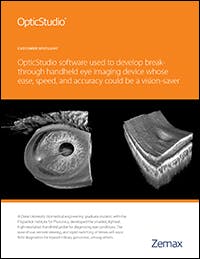Optical design requirements for handheld imaging devices
Point-of care or point-of-procedure imaging devices have different requirements than the typical MRI, CT, or x-ray machines do. Here are five optical design requirements, and how software like OpticStudio from Zemax helps optical engineers satisfy them.
Requirement 1: Must be small and portable
When seconds count in an emergency situation, doctors and nurses need to be able to quickly access handheld imaging devices to assess and react to a problem. And, in general healthcare use, the smaller the imaging device, the more space it saves in a hospital or clinic.
Software tools can help optical engineers design thinner and lighter optical systems for medical use. Ray tracing with OpticStudio from Zemax is valid down to a scale of around ten times the wavelength. For smaller objects, Zemax and Lumerical jointly developed interoperable tools that allow engineers to simulate nano-optical effects using ray tracing and Maxwell equations. Using a combination of Lumerical FDTD solutions and OpticStudio, ultra-thin optical component meta-surfaces can be designed.
Requirement 2: Must be fast
The draw of portable imaging devices is that caregivers are able to access images instantly, making them more efficient in point-of-care situations.
“Fast” in a handheld imaging device can refer to several parts of the optical system overall. For example, engineers at University of Illinois at Urbana-Champaign created a 3D medical scanner with three main components: a near-infrared light source and optical coherence tomography (OCT) system, a video camera, and a MEMS-based scanner to direct the light. So, fast could refer to anything from lens speed to the speed of the beam hitting the sensor in the MEMS scanner.
Requirement 3: Must produce high-resolution images
Without high resolution, critical health issues can get missed. That’s why the image resolution needs to be as high as possible on handheld imaging devices.
Optical design software can help engineers predict the resolution of an image. For example, OpticStudio’s Image Simulation feature quickly and accurately predicts the appearance of any scene as imaged by the optical system. The method works by convolving a source bitmap file with an array of Point Spread Functions. The effects considered include diffraction, aberrations, distortion, relative illumination, image orientation, and polarization. The feature is very fast and gives excellent signal-to-noise in the final image.
Requirement 4: Must be cost effective
Cost is a critical component of designing an optical system for manufacture. OpticStudio’s Cost Estimator tool allows optical engineers to send lens data to manufacturers and get real-time cost estimates. The designer can see the cost impact of lens shape, size, material, coatings, quality, and quantity. This capability is unprecedented in the optical design software industry and particularly critical for engineers designing handheld imaging devices, which cannot be cost-prohibitive for hospitals and clinics.
Requirement 5: Must be safe for use
It goes without saying that handheld imaging devices must be safe for both caregivers and patients.
Safety-critical devices must get it right the first time. It’s hard to bounce back if your product accidentally hurts people. Beyond the inevitable law suits, your reputation is forever lost. When safety is of the upmost importance, you must demonstrate the team has meticulously tested usage scenarios. For example, when you’re developing a device that points a laser to the eye, you are more likely to get FDA approval if you can show how you’ve exhaustively modeled it, and how it works every time.
Zemax Virtual Prototyping is the only solution on the market today that enables engineering teams to simulate optical performance on the entire optomechanical product before creating a physical prototype. Using OpticStudio in concert with LensMechanix for optomechanical engineers, it’s easy to assess where issues are coming from—and fix errors before they become safety hazards.
Customer story: OpticStudio used to develop break-through handheld eye imaging device
A Duke University biomedical engineering graduate student used OpticStudio to develop the smallest, lightest, high-resolution handheld probe for diagnosing eye conditions.

